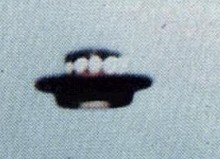Article/Document:
Scientific Inference (Sturrock Panel Report on UFO Physical Evidence)
Peter Sturrock / Sturrock Panel Report / Physical Evidence Related to UFO Reports
original source | fair use notice
Summary: In attempting to resolve a complex problem such as that posed by UFO reports, one is very much in the "gray area" of scientific research that is not well defined: the facts are to some extent shaky; some of the hypotheses are speculative; and it is not clear how to evaluate the hypotheses on the basis of the facts and of other relevant information.
In attempting to resolve a complex problem such as that posed by UFO reports, one is very much in the "gray area" of scientific research that is not well defined: the facts are to some extent shaky; some of the hypotheses are speculative; and it is not clear how to evaluate the hypotheses on the basis of the facts and of other relevant information. Furthermore, one has the difficulty of relating the analysis of individual reports ("Is this report due to a hoax?") to the global questions represented by the hypotheses ("Are some reports due to hoaxes?"). In such a situation, it is essential to have some way to organize one's analysis of whatever research is being conducted. Scientific inference is the intellectual basis of science, and the procedures of scientific inference offer a framework for organizing such analyses. (See, for instance, Good, 1950; Jeffreys, 1973.)
The formalism of scientific inference involves expressing all judgments in terms of probabilities. Where there are definite rules for deriving probabilities from the evidence, these rules can be used; otherwise, the probabilities may be regarded as subjective. If each judgment is made by several investigators, this can provide both a mean or consensus estimate and a measure of the degree of uncertainty of that estimate. For a recent exposition of this formalism, see for instance Sturrock (1994d).
In investigating any specific case, it is necessary to work with a complete and mutually exclusive set of hypotheses. The following set of 8 hypotheses was used in Sturrock's survey of the members of the American Astronomical Society (Sturrock, 1994a; 1994b; 1994c):
a. Hoax,
b. Some well established phenomenon or device,
c. Some well established but unfamiliar natural phenomenon,
d. Some unfamiliar terrestrial technological device,
e. Some hitherto unknown natural phenomenon,
f. A technological device not of terrestrial origin,
g. Some other cause which [the investigator] can specify, and
h. Some other cause which [the investigator] cannot specify.
An investigator may begin by assigning "prior probabilities" to these hypotheses, although this is not essential. If so, each value must be greater than zero and less than unity, and they must sum to unity. Once these prior probabilities have been assigned, the investigator should then forget about his prejudices. Bayes' theorem then provides a mechanism for updating one's assessment of probabilities on the basis of new evidence. The new evidence may be a single case or an analysis of a catalog of cases. When measurements are made in terms of "log-odds" defined by log[(p/(1 - p)] rather than the probability pitself, it turns out that investigators with very different prejudices should assign the same weight of evidence, measured by the change in log-odds, to the same experimental or observational data. Hence, although they may differ in their prejudices, they should be able to agree in their assessments of the evidence.
It is even more convenient to work in terms of the quantity 10*log[p/(1-p)], since one may then use the familiar engineering term "db" or "decibel" to represent an assessment. For instance, if one begins with the assessment that the probability of an event being due to an extraterrestrial vehicle is 10-6, one could rephrase that as saying "my assessment is -60 db." If a certain research program made that proposition even more unlikely by, say, 10 db, one would then lower that assessment to -70 db. If, on the other hand, the evidence seemed to support that hypothesis with weight 10 db, the resulting assessment would be -50 db. If six separate and completely independent studies were each to yield evidence of 10 db, the investigator would end up with an assessment of 0 db, which represents even odds of the proposition being true. That is, the evidence would have been just sufficient to change the mind of the investigator from being highly skeptical about the hypothesis to considering it just as likely to be true as not true.
It is highly unlikely that any research project that is in operation for only one or two years will solve the UFO problem. However, it could and should provide useful relevant evidence, and that evidence should lead to a measurable change in the assessments of an interested scientist. In an area such as that of UFO research, that is all that can be expected. On the other hand, several research projects, each lasting a reasonable length of time, should provide sufficient evidence that an hypothesis may be effectively definitely established or definitely rejected.
If these suggestions are considered to have merit, they could be developed into a more specific and more useful form by means of a workshop that brings together UFO investigators, professional investigators (of accidents, failures, etc.), physical scientists, and statisticians.
Read more articles on this topic:







